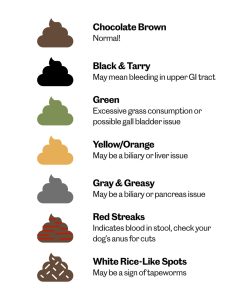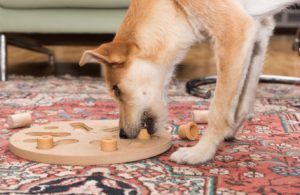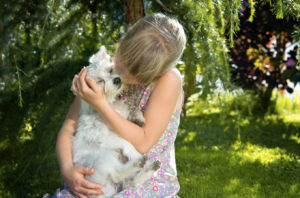Every dog does it.
While it may not be our favorite thing to think about, a dog’s poop is an important indicator of their overall health. As responsible dog owners, it’s important to know what healthy dog poo looks like, as well as common bowel problems your dog may encounter throughout their life.
What Does Healthy Dog Poop Look Like?
Healthy dog poop is characterized by a few factors: consistency, coating, size, shape, and color.
Consistency: In general, dog poop should be easy to pick up, solid, and not too watery. Your dog’s poop should stay in one piece when you pick it up, but should still feel soft, moist, and squishy. It should not feel dry or hard, nor should it be runny. Changes inconsistency (ie., if your dog pooped water) may be indicative of dog diarrhea or constipation.
Coating: When you pick your dog’s poop off the grass, there should be no trail left behind. If there is a coating of mucus left on the grass, or you see oily stool, we recommend contacting your vet.
Size: For size, consider how much your dog eats. The quantity of food they eat should be proportionate to their poop size. Fiber is important for digestion and a lack of fiber can leave your dog with too little poop.
Shape: Dog stool should be log-shaped and in one piece. Rounder poop can indicate dehydration in a dog and should be carefully watched.
Color: The ideal poop color is chocolate brown. Any other color can be an indication of a more serious issue (such as neon green diarrhea) which we will break down in the next section.
While it may not be the most pleasant part of taking care of your dog, you should check your dog’s poop daily to see if there are any noticeable changes. If your dog appears to be straining to poop, take note of that too.
It’s also important that your dog has bowel movements at least once a day.
Dog Poop Chart: Color Guide
A dog’s poop color is one of the main things pet owners should keep an eye on. A change in color can rapidly indicate health problems, allowing you to take your dog to a vet for immediate care.
If you’ve noticed a strange color within your dog’s poop, you can use our unhealthy dog poop colour chart below for an idea of the possible issue. Always consult your vet about any changes in your dog’s health, including their stool.

Let’s break down the different colors of dog poop and what they might mean:
Chocolate brown poop: This is an indicator of good digestive health and the color you want to see. A healthy poop should be completely brown without any differently-colored specks or streaks.
Green poop: This could indicate a parasite, rat bait poisoning, or other health issues. Sometimes dogs ingest a large amount of grass, which can also give their poop a green color. Consult your vet for advice.
Black or very dark brown poop: Black or dark brown poop or a dog pooping black liquid may indicate bleeding in a dog’s upper GI tract, stomach ulcers, or your dog’s consumption of human medications. Aspirin in particular can make your dog’s poop very dark. Never give your dog human medications without your vet’s permission first. Contact your vet for your next steps if your dog’s stool is unusually dark.
Red or red streaks in their poop: Typically a sign of bleeding, this is often due to inflammation, anal gland infections, or injury to the dog’s rectum. Excessive straining to poop can also cause bleeding. Take a look at your dog’s rectum to see if there are noticeable injuries and consult your vet.
Purple or pink poop: This is generally a sign of hemorrhagic gastroenteritis (HGE), which is extremely serious. Many dogs die of this every year, but prompt medical attention can prevent fatality. Immediately seek emergency medical attention if you notice this stool color.
Greasy or gray poop: If your dog’s poop is shiny or fatty, this is often a sign of exocrine pancreatic insufficiency, which is more commonly known as maldigestion. This is usually highly treatable with an appropriate diet.
Orange or yellow dog poop: Orange or yellow poop is typically a sign of a liver issue, food intolerance or biliary disease. Check with your vet to have your dog scanned for any underlying medical problems.
Common Causes of Bowel Issues
Dogs, especially puppies, have a knack for getting into things. This can lead to them ingesting odd things, which will show up in their stool.
You may see things like grass, bits of plastic, or fur in their stool. It’s important to contact your vet immediately if you notice this because they may have been unable to pass everything they ingested, leaving them with potential blockages from the foreign object in their digestive tract.
Take care to look at your dog’s fresh stool to check for things like worms. Worms can look like little pieces of rice in your dog’s poop. Worms can find their way into a dog’s stool when it’s been sitting outside, so always check your dog’s stool when it’s fresh.
Diarrhea and constipation are more common bowel issues and show up in the consistency of your dog’s stool and the frequency of their bowel movements. If your dog suddenly stops pooping or begins pooping excessively, this is a sign of some kind of upset. Keep an eye out for these changes, your dog will thank you!
Indications of Bowel Discomfort
Bowel discomfort is oftentimes a symptom of constipation. Your dog may indicate bowel discomfort in a variety of ways, including:
- Scooting (dragging their butt along the ground)
- Attempting to poop, but being unsuccessful
- Circling excessively
- Squatting frequently
- Eating grass
- Crying or scratching themselves
Some dogs may have a tight, painful abdomen. Try gently pressing down on their stomach or lower back to see if they are uncomfortable. If they are, consult your vet.
Diet: Quality & Quantity
As the old adage goes, you are what you eat. This is just as true for our dogs, as it is for us!
When it comes to your dog’s food, feeding them a high-quality diet filled with nutritious, but delicious foods they enjoy is so important to your dog’s overall health and poop quality. Keeping your dog hydrated will also improve their stool quality.
Many dogs have food allergies and sensitivities. In addition to skin disease, these can cause digestive upset and even change the color of your dog’s stool, most commonly to an orange or yellow color.
It’s also crucial to prevent your dog from rummaging through the trash, eating plants, or getting a hold of other household products or chemicals. Some human foods are also advised against, so make sure you’re not feeding your dog any of them!
Here at PetPlate, we work tirelessly to provide the highest quality food for your precious pup! Our veterinary nutritionist ensures that your dog is getting a balanced diet filled with top-notch, human-grade ingredients. Your dog’s health is reflected in their poop and feeding them a high-quality, healthy diet will help them to have less upsets and less costly visits to the vet.
All of our meals offer dietary benefits, but I’d particularly recommend our Tail Waggin Turkey and Lean & Mean Venison. Both are easy to digest and great for sensitive stomachs. I’d also advise you to check out our digestive supplements for dogs. This is a full dose of probiotics in the form of a delicious cookie, which can have a big effect on improving stool quality and overall gut health.
Common Questions About Dog Poop
As dog poop is so variable, there’s naturally plenty of questions floating around! Here’s detailed answers to the ones we see the most.
- How often should a dog poop?
A dog should poop at least once a day. The frequency may match how many meals they eat a day. - Why does my dog poop so much?
If your dog has a sudden increase in bowel movements, this is usually a sign of diarrhea. Diarrhea is often caused by eating too much food or the wrong type of food. It can also be a result of stress. Do keep in mind that puppies will poop much more frequently than adult dogs, which is totally normal! - How much should my dog poop?
Your dog’s poop quantity should match how much they eat. Fiber allows your dog to fully eliminate. If their poop quantity is much smaller than what they consume, check how much fiber they are eating every day. Again, a well-balanced diet will help your dog to be regular and healthy. - How can I make my dog poop quickly?
If your dog is in pain and unable to poop, reach out to your vet. They may provide a stool softener medication, which will allow your dog to pass their stool. Your dog can then be assessed for any underlying medical problems that may be making it difficult for them to poop. - What are white worms in dog poop?
White worms in a dog’s poop can be intestinal parasites, such as tapeworms. Watch out for tiny, off-white pieces in your dog’s poop – it may resemble rice or sesame seeds. We recommend taking your dog to the veterinarian immediately to be treated if you find these.While tapeworms in dog poop are relatively easy to spot, other kinds of worms are not. The hookworm, another common parasite in dogs, is only 2-3mm long. This makes hookworms in dog poop nearly invisible to the naked eye. However, there are other symptoms of worm infection to look out for – such as diarrhea, blood in the stool, lethargy, and weight loss. - Why does dog poop turn white?
Dog poop can turn white when a dog consumes too much calcium in their diet. This occurs more regularly with dogs that eat a raw diet. Feeding your dog a complete and balanced diet will help prevent this. - How can I help my dog poop?
A dog struggling to poop is oftentimes constipated. Ensuring they have plenty of water is one way to help them poop, as dehydration is a frequent cause of constipation. A healthy, consistent diet with plenty of fiber will keep them regular as well. - What do whipworms look like in dog poop?
Whipworms can appear as whitish flakes in a dog’s stool. They may also cause your dog to have diarrhea or bloody stools. Due to their hardy nature, whipworms need to be treated by a vet, as they can live for up to five years in your dog’s body. - What does giardia look like in dog poop?
Giardia is a parasite that infects a dog when it’s consumed during the parasite’s cyst stage. A dog with a Giardia infection may have fatty, greenish stools. There may be blood in the stool as well. Immediately reach out to your vet if your dog shows these signs. - Why is my dog pooping blood?
Blood in dog stool can indicate an injury to the rectum, inflammation, or anal gland infections. Consult your vet right away if your dog is pooping blood for appropriate treatment. - Why does my dog take forever to find a place to poop?
Many dogs are cooped up all day and may stall to prolong their time outdoors. Try allowing your dog more free time outdoors to eliminate this behavior. Training your dog to poop in the same spot can also speed up this process. - Why do dogs eat poop?
Stool eating is a relatively common behavior seen in dogs. Many assume that it’s a sign of a nutritional deficiency, but there’s no known links between your dog’s diet quality and their tendency to eat poop. In most cases, it’s just a bad habit.Your dog may have learned this behavior from another dog, or they’re simply very food-driven – dogs are natural-born scavengers after all! If it’s an old habit, it’s likely a behavioral issue. However, if your dog has suddenly started eating poop without any prior history, it could be indicative of an underlying health problem. - What can I give my dog for diarrhea?
If your dog is experiencing diarrhea, it’s a good idea to feed them something easily digestible. Check the list below to find out what to feed a dog with diarrhea – but remember to get your vet’s advice before making any dietary changes.- White rice
– Boiled potatoes without skin
– Plain greek yogurt
– Skinless chickenIf your dog’s diarrhea continues, take them back to the vet’s office for a full checkup. - What can I give a puppy for diarrhea?
It isn’t unusual for a puppy to experience diarrhea when first introduced to a new home. The stress of the new environment can easily lead to a few loose stools. You may have also chosen to transition your puppy to a new diet, which can be another factor. Ensure your puppy remains well-hydrated during the bout of diarrhea and consider giving some easily digestible food.That said, there can be more serious causes such as parasites or a virus. If the diarrhea contains blood or lasts longer than a few days, seek a vet immediately.
Fresh Dog Food is Gentler on the Stomach
Just like us, our dogs are what they eat and poop is a significant sign of good or poor health. Regularly look at your dog’s fresh stool to check for any significant changes and reach out to your vet with any of your concerns. A healthy, balanced diet is one of the most important components for healthy stools.
Pet Plate offers four delicious varieties of human-grade meals that will both excite your pup and provide them with wholesome nutrition, formulated by our veterinary nutritionist for a complete and balanced diet.
With Pet Plate, your dog will also receive the precise amount of food they need for their size and breed. This is to prevent over- or under-feeding. Any food sensitivities and allergies should also be carefully considered when selecting your pet’s diet. All of our meals are easy on the digestive tract and wonderful for promoting healthy poops and better health!
Sources:

